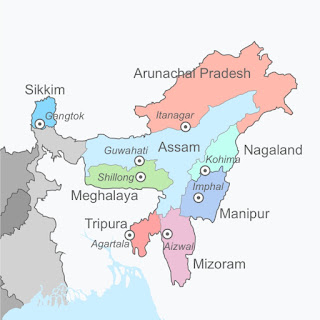Assam is a state in northeastern India. The first dated mention of the region comes from the ''Periplus of the Erythraean Sea'' (1st century) and ''Ptolemy's Geographia'' (2nd century) which calls the region Kirrhadia after the Kirata population. In the classical period and upto the 12th century the region east of the Karatoya river, largely congruent to present-day Assam, was called Kamarupa and alternatively, Pragjyotisha. Though a western portion of Assam as a region continued to be called Kamrup, the Ahom kingdom that emerged in the east, and which came to dominate the entire Brahamputra valley, was called Assam
Gold Mohur, Assam, 1780-1795 AD
Ptolemy's Geographia (2nd century)
Ptolemy's Geographia (2nd century)
According to a late text, Kalika Purana (9th-10th century AD), the earliest ruler of Assam was Mahiranga Danav of the Danava dynasty. The last of these rulers (who were Naraka of Bhauma dynasty), was slain by Krishna. Naraka's son Bhagatta (mentioned in the Mahabharata) fought for the Kauravs in the battle of Kurukshetra.
Assam Valley, Satellite photograph
Arjuna shoots Bhagadatta
Evidence of civilization in Assam around 2nd century BC, is seen on a rock cut stupa at Sri Surya Pahar, contemporary with rock cut Karle and Bhaja caves of Maharashtra. Samudragupta's 4th century Allahabad pillar inscriptions mention Kamarupa and Davaka (Central Assam) as frontier kingdoms of the Gupta Empire. Davaka was later absorbed by Kamarupa which grew into a large kingdom that spanned from Karatoya river to present day Sadiya and covered entire Bhramputra valley, North Bengal, parts of Bangladesh and at times Purnea and parts of West Bengal.
Inscription by Gupta king Samudragupta, 2nd century AD
Sri Surya Pahar gateway
The kingdom was ruled by three dynasties, the Varmanas (350-650 AD), the Mlechchha dynasty (650-900 AD) and the Kamarupa-Palas (900-1100 AD), from their capitals in present-day Guwahati (Pragjyotishpura), Tezpur (Haruppeswara) and North Guhati (Durjaya) respectively. Later, after weakening and disintegration, the Kamarupa tradition was extended to 1255 AD by the Lunar I (1120-1185 ad) and Lunar II (1155-1255 AD) dynasties.
Kamarupa Kingdom, 350-1140 AD, what is today's Assam, Bengal and Bhutan
Three dynasties were prominent in the medieval era. The Chutia, a Bodo-Kachari group that held regions on both banks of Brahamputra , the Ahoms, a Tai group that ruled Upper Assam and the Dimasa, another Bodo-Kachari dynasty. that ruled from Dikhow river to the central and southern Assam. Until early 1500s, the Ahoms ruled a small kingdom in Sibsagar district and suddenly expanded during King Suhugmung's rule due to weakening of the Chutia and Dimasa kingdoms. Thereafter, for about 600 years (1228-1826 AD) the Ahoms ruled.
Chutia kingdom along with the Ahom kingdom, 1415 AD
The Ahom kingdom, 1769 AD
Despite numerous invasions, mostly by the Mughal rulers, no power could rule over Assam, till the British. The Mughals made 17 attempts to invade but were never successful.
During the Colonial era, the discovery of Camellia Sinesis (tea plant) in 1834 in Assam led to tea plantations proliferated in Eastern Assam, where the soil and the climate were mostly suitable. By 1850s, the industry started seeing profit, and the local Camellia assamica became the most suitable variety.
Camellia sinensis
In the later part of the 18th century, religious tensions led to the Moamoria rebellion (1769-1805), resulting in a civil war and the Burmese capture of Ahom rules Assam. Due to the atrocities by the Burmese, the Assam people reached the East India Company for help. The British gradually annexed the region and introduced Bengali as the medium of instruction in Assam, instead of Assamese. Assamese literature therefore suffered. Initially, Assam was part of Bengal Presidency, then in 1906, it was made a part of Eastern Bengal and Assam province, and in 1912 it was reconstituted into a chief commissioner's province.
Map of Eastern Bengal and Assam during 1907-1909 AD
At the turn of the 20th century, British India consisted of eight provinces and Assam was one of them. With the partition of India in 1947, Assam became a constituent state of India. Assam thereafter got split into several parts. In 1963, the Naga Hills district became the 16th state of India under the name of Nagaland. In 1972, Arunachal Pradesh and Mizoram were separated from Assam as union territories and became states in 1986. Meghalaya State was formed in 1972.
Present day Assam and other states around it
Coins of Assam
Rudra Simha, Rupee, silver, weight 11.3 g
Obverse: four lines Assamese legend: sri srimat/ swarga deva rudra / simhasya sa/ke 1622, lion right below
Pramatta Simha, 1744-1751, silver, Rupee, weight 11.2 g
Obverse: four-line Assamese legend: sri sri swarga/ deva pramatta/ somha nripasya/ saka 1672, lion left below
Reverse: four Assamese legend: sri sri hara/ gauri charana/ kamala madhu/ karasya
Pramatta Simha, silver Rupee, weight 11.2 g
Obverse: four-line Assamese legend sri sri swarga/ deva pramatta/ simha nripasya/ saka 1672, lion left below
Reverse: four-line Assamese legend: sri sri hara/ gauri charana/ kamala madhu/ karasya
Gaurinatha Simha, 1780-1795, gold mohur, weight 11.2 g
Obverse: four-line Assamese legend: sri sri swarga/ deva sri gaurina/ tha simha nripasya/ saka 1705, lion below left
Reverse: four-line Assamese legend: sri sri hara/ gauri charana ra/ binda makaranda/ madhu karasya
Gaurinatha Simha, 1780-1795, silver Rupee, weight 11.0 g
Obverse: four-line Assamese legend: sri sri swarga/ deva sri gaurina/ tha simha nripasya/ saka 1716, lion below left
Reverse: four-line Assamese legend: sri sri hara/ gauri charana ra/ mala makaranda/ madhu karasya
Assam


























No comments:
Post a Comment
Any inputs or feedback is welcome!